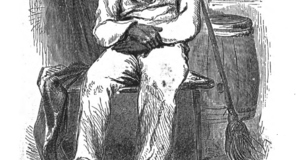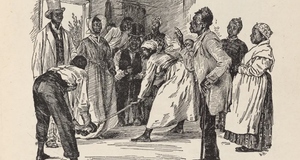From Flourishing Industrial Slavocracy to Restrictive Tenancy and Re-Enslavement: The Southern Labor Force Before and After the Civil War
By
2021, Vol. 13 No. 05 | pg. 1/1
IN THIS ARTICLE
KEYWORDS
AbstractSome scholars of American history suggest the institution of slavery was dying out on the eve of the Civil War, implying the Civil War was fought over more generic, philosophical states' rights principles rather than slavery itself. Economic evidence shows this conclusion is largely incorrect; the industrial slavocracy of the south was thriving—Southern aristocrats had every reason to fight the prospect of abolition, for the Southern economy and capital structure was almost exclusively on the ownership of Black men and women. After the war, repression continued through economic means, as former slaves became sharecroppers trapped in restrictive tenancies with little to no upward mobility. As Reconstruction and the Freedmen’s Bureau were chased out by local and state authorities in the former Confederacy, hundreds of thousands of freed slaves, silenced at the hand of white supremacy terrorism and voter suppression, faced physical enslavement once again through the criminality exception to the 13th amendment. No Slavery, No SurvivalIn the decades following the presentation of Alexander Hamilton’s iconic Report on Manufactures, which urged Congress to support domestic manufacturing and technological innovation to alleviate dependency on expensive foreign exports and uncuff U.S. foreign policy from the nation’s economic shortfalls, the North saw an explosion of factory-based industry, bolstering the growth of a populous working class. The South, while also employing several of these mechanisms, remained wedded to their capital structure of slave labor—largely upholding the prevailing aristocracy, laid out through a system of rich plantation owners, poor sharecroppers, and disenfranchised Black workers. During the Antebellum period, along with an expansion of manufacturing and textiles, the North saw an expansion of its agricultural economy as well, with a diverse culture of crops with regional and overseas demand extending from the Northeast to the Midwest. The South, however, remained heavily reliant on international demand for the stable crop that had consistently propped up the Southern economy since the invention of the cotton gin, which turned a plant that was not suited to the climate, ruined the soil it was grown on, and heavily labor intensive in its cultivation into a “king” crop. By the 1830s, over half of the value from all exports from the U.S. came from cotton (North 1961). By 1850, over half of the slaves in the Southern states were working on cotton plantations, with approximately 75 percent of their product exported overseas as a crucial component of the global industrial revolution of the 19th century. In 1860, the holdings of slaves were conservatively estimated in one study to have constituted 45.8 percent of the total wealth held by the top five cotton producing states (Ransom 12), even though two-thirds of the Southern population did not own more than fifty slaves. To put this into perspective, all land capital, buildings, and other real estate together accounted for 35.5 percent of total wealth in the top five cotton production states. This rampantly unequal system was held together by the sentiment of white supremacy and race control of the Black population shared by both poor and rich whites, as well as the looming fear of slave uprisings. In this way, both the Northern and the Southern economy were experiencing high productivity growth during the Antebellum period, which refutes the hypotheses of many historians, most significantly Ulrich B. Phillips and Charles W. Ramsdell, who stated that the slave system had both stagnated the economic development of the South in the mid-1800s and had become unprofitable to slaveowners on the eve of the Civil War.
The reason why the slave system persisted, supposes this initial conclusion, was solely for the purpose of race control, to prevent Black people from unleashing their perceived savagery upon the country. In an economic sense, this is only one element of the story. There is extensive evidence in economics literature that finds the institution of slavery to not have been slowing, but actually expanding and finding itself more profitable than ever on the eve of the Civil War. Furthermore, in a cultural sense, there is a gaping flaw in what economist Stanley Engerman refers to as the Phillips-Ramsdell hypothesis; notwithstanding the looming threat of slave uprisings following the Nat Turner rebellion, it was only after the Civil War and in the contentious clutches of Southern Reconstruction that this dramatic, cultural concern regarding Black people’s dangerous tendencies became a common sentiment across the country, culminating in cultural phenomena such as the D. W. Griffith film Birth of a Nation (1915). Prior to the furious debates over abolition that preceded the Civil War, Black people were seen as slow and simplistic but ultimately gentile and content in their roles as enslaved laborers and house workers, which is why the vast majority of white Americans both in the North and the South (Perkins 507) believed slavery was ultimately “good” for Black individuals, as opposed to the violent offender image generated as justification for arresting and re-enslaving free men after emancipation (Taylor 214), which will be covered later in this article. Labor Capitalization and The Marginal Product of Labor: Cotton Prices are Not EnoughIn an economic context, there is plenty of evidence that the “slavocracy” of the south was in no way an impediment on the Southern agricultural economy nor on course to die out on its own on the eve of the Civil War. Among the “cotton states,” according to an analysis computed by economic historian Gerald Gunderson in 1974, around half of the general population was enslaved. Per capita earnings of free whites were particularly high in Mississippi, Louisiana, and South Carolina. Across these states, the fraction of these earnings from slavery averaged 30.6 percent (Gunderson 922, Table 1), going as high as 41.7 percent in the state of Alabama and 35.8 percent in South Carolina. Furthermore, Engelman points out that the Phillips-Ramsdell conclusion in its analysis overlooked the sheer volume of labor capitalization experienced in the southern slave economy via slave reproduction, and did not take into account the returns from slaves bearing children as a capitalized investment with significant returns to overall plantation income (Engelman 77). Extensive empirical research in this area came from Japanese economist Yasukichi Yasuba, who in his study “The Progitability and Viability of Plantation Slavery in the United States” calculated the capitalized rent of rearing a male slave child as a proportion of the average price, which is defined as the portion of a slave’s value above the investment needed to raise a slave to working age. Yasuba’s model makes clear that along with income from child labor, capitalized rent grew substantially. From 1821 to 1825, the capitalized rent for an 18-year-old male slave was 58 percent of the average price. That number grew quickly within ten years, reaching 75 percent in 1835, before jumping up to 99 percent by 1860 (Yasuba 66). There is a clear upward trend here in an 18-year-old male slave’s market value above the costs needed to raise him to that age, almost reaching the double threshold on the eve of the Civil War. A further component of the capitalized rent is the income brought on during the slave’s childhood years, income whose upward trajectory is clearly depicted in the aggregate value increase from 1821 to 1860. As a result of these factors studying the value growth of enslaved labor, Yasuba concludes in his study that, “in the Antebellum South, slavery steadily strengthened its economic position” (67). The potential consequences of this dramatic loss of slave capital were reflected in the actual economic fallout introduced by emancipation. Slavery was in no way dying out on the eve of the Civil War. It was flourishing, expanding with muster.
In terms of profitability, Jeremy Atack and Peter Passell address the arguments made in Ramsdell’s “The Natural Limits of Slavery Expansion” that the long-term downward trend in cotton prices was indicative of declining lucrativity of enslaved labor. They point out that it was increased productivity and subsequently lower production costs that would explain such declining costs (Atack 331). Cotton would still remain a top commodity in the North and among international buyers, with cotton production showing no signs of resignation. And as mentioned before, the labor investment in cotton production saw a substantial increase in the years leading up to the Civil War. Atack and Passell also point out that simply looking at cotton prices was a self-established limitation that excluded the possibility of slavery expanding into other agricultural industries such as the growing grain industry of the Midwest, as well as other potential crops on the expanding Western frontier. Along with Atack and Passell, Engelman’s summary of the work of Richard Sutch and Yasuba states that in general, as long as slaves’ marginal product of labor minus subsistence wages exceeded that of free labor minus the market wage rate, there was a profit to be made and an economic surplus to exploit (77). There is clear evidence, through both an economic lens and the changing cultural dynamics surrounding the cultural perception of Black people, that the slavocracy of the South was booming in the Antebellum era and showing no signs of dying out on its own. The stakeholders of the Confederacy had a very real vested economic interest in rejecting abolition and fighting against the Union during the Civil War. Postwar Economic SlaveryRoger Ransom and Richard Sutch of the University of California conducted a study of southern agricultural output following the Civil War and emancipation. Given that we have established the extent of the South’s dependence on agricultural productivity and the enslaved labor force in 1860, it’s not surprising that emancipation decimated the southern economy, which would never recover within the remainder of the century. However, Ransom and Sutch cite the research of John F. Stover (1955) and Daniel Lerner (1959) in noting that while the southern agricultural apparatus was decimated, the southern manufacturing and transportation sectors experienced a “rapid regeneration” from the wartime destruction thanks to postwar Northern investment, reaching pre-war working order by 1867 (3). But these sectors were not the backbone of the Southern economy. Ransom and Sutch prepared estimates for per capita output of the five major cotton producing states. Their study is inclusive of five crops that accounted for above 97 percent of the product as reported in the 1880 agricultural census. Between 1859 and 1866, per capita crop output fell 71.3 percent before rebounding at an annual rate of 22.2 percent in the period between 1866 and 1870, before levying off at approximately 60 percent of its peak from the Antebellum period (5) for the remainder of the 19th century. Prices remained high in the immediate postwar era, as the American south remained the world’s top exporter of cotton. After weighting for postwar inflation, the 1866 price for a pound of cotton was 30.7 cents, which dropped to 22.9 cents by 1867, reaching 17.8 cents by 1868 (6). Despite massive decline, these rates were still fairly high as a result of continued demand at home and especially broad that could not be met with the stock of labor that had been severely damaged by emancipation, from which the Southern economy would never recover. In addition to massive investment losses, cotton planters had a hard time securing a workforce and subsequently credit for the planting season, but did their best in the tenant farming system of the postwar era. Historian Gavin Wright put it thus: emancipation turned white agricultural landowners from “laborlords” to “landlords.” As a result, cotton exports suffered and so did the incomes of cotton planters. In Ransom and Sutch’s 1979 study, gross southern crop output dropped from 1.57 percent growth from 1874 to 1884 down to 0.97 percent from 1889 to 1899 down to 0.21 percent from 1894 to 1904 (Ransom 140, Table 7.3). As previously stated, the labor force in the postwar south experienced an extraordinary shortage, with the Department of Agriculture estimating that the effective labor supply was a third of Antebellum levels in 1867, which introduced a substantial handicap to economic recovery following significant slave capital (investment) losses mostly due to emancipation, as opposed to alternate hypotheses such as wartime destruction or the fact that 1.6 percent of the southern Black population was estimated to have perished in the war (10). These alternate hypotheses no longer serve much relevance to this conversation. The effects of emancipation, which Ransom and Sutch emphasize, is too frequently viewed from the perspective of the slave owner. The disappearance of nearly half the South’s capital stock following the Civil War wasn’t necessarily something that was lost to plantation owners, but rather transferred over to the freed slaves themselves as a type of human capital (13). Furthermore, Ransom and Sutch’s conservative estimate for the percentage decline in man-hours per capita offered by the rural Black population as a consequence of emancipation was 28.3 percent, while their high estimate was 37.3 percent (14). This makes sense, as “the slave was literally worked to the limit of his economic capacity. As a free man he quite naturally chose to work less, so that he might reserve a portion of each day within which to enjoy the fruits of his labor, fruits which had previously been taken from him by his owner” (21). Therefore, in order for regenerative growth beyond that given by the increased relative marginal product of labor due to the percentage decline in the labor supply exceeding the percentage reduction in the supply of other production factors (15), as well as the recovered losses of livestock capital and transportation methods (20), the South had to rely not on labor surplus exploitation, but rather on the population as a whole. Barriers to Upward MobilityThe new Southern economy was driven by two distinct incentives. Historian Harold D. Woodman described these incentives in the following manner: “The planter sought to return his lands to production using a reluctant labor force, while the freedman, without land or property, sought a status as far removed from slavery as possible” (324). In other words, ex-slaves were looking for more flexible opportunities for self-sustenance and upward mobility while Southern capitalists were looking for ways to retain their workforce in the interest of making up the lost economic strength under slavery. One of these groups, of course, held a significant advantage in their endeavor. Woodman’s analysis is mainly of the laws surrounding postwar tenantship, which were nascent in the immediate postwar period as freedman drifted toward sharecropping because of its relative flexibility, its proximity to food resources, and “wages,” which were often paid in the form of crop or cash. Woodman suggests that the sharecropper “was a wage laborer, his wages being a portion of what he produced paid to him by the landlord” (325). Laws were quickly passed by Johnsonian reconstructionist legislatures which lent considerable power to lenders by considering the cropper an employee and giving landlords a statutory lien for rent on the proceeds of the crop after harvest (327). “A tenant or cropper without cash or an alternative source of loans had no choice but to accept the terms as offered,” Woodman writes (332). “With control over expenditures the lender dictated production decisions.” However, tenants still had the option to simply pack their bags and find employment elsewhere and leave their bosses with an unfinished crop and unpaid debt (335) but as a Black freedman, you would get sued by your landlord and be subject to legal fees that you could not afford, as well as racist lawyers and judges that sought to keep you bound to the land, not to mention violence and intimidation tactics or other forms of physical threat. In the legal apparatus, in addition to the aforementioned obligations, anti-enticement laws were quickly passed further restricting the labor mobility of sharecroppers by making it a criminal offense to sign a contract without finishing the associated work requirements. Legal restrictions on mobility and autonomy in the postwar Southern labor economy that plagued the freedman labor force were directly tied to the economic restrictions on freedmen labor. In “Freedom and the Southern Economy,” Gavin Wright writes extensively on the economic discrimination that would inevitably take place in a racist society, which means to the freedman there was no such thing as an “impersonal wage.” For many ex-slaves, emancipation ostensibly purported to offer a grand opportunity for upward upward mobility and self-determination via the protections of the market, but the protections of the market are substantially less valuable if wage descrimination on the basis of race by employers—reflected in the form of high differences in land-labor ratios and the low fortunes of tenants—served a useful and profitable vehicle for labor exploitation. As noted in the previous paragraph, the legal circumstances certainly did not offer remedies to this dynamic. To use the example of sharecroppers’ accessibility to necessary capital to conduct their work, “the rising barriers to the acquisition of mules, tools, and fixed-rent tenure had important social consequences as well, because there is reason to believe that the sharecroppers of 1910 had less of the day-to-day independence and decision-making scope described by Ransom and Sutch” (Wright 104). Therefore, it was clear that a substantial portion of these laws were targeted specifically toward freedmen in their pursuit for employment as far from slavery as possible. Taking all of this into consideration, it was clear that while poor whites were more free to take up tenancies with autonomy and a guaranteed share of the crop, poor Blacks were restricted to sharecropping where they held little to no power of mobility or self-determination as a result of racially motivated economic and legal discrimination. Re-Enslavement via the 13th AmendmentThere is a further, less economically motivated component to the former Confederacy’s attempts to reconsolidate its labor supply, which was based mostly in notions of race control, in the Phillips-Ramsdell sense, that re-emerged into prominence as Reconstruction efforts (most importantly, the North’s efforts to restructure the labor systems along the implications of emancipation) were abandoned in the later years of the 1800s. Mob violence and the birth of the Ku Klux Klan, the rise of faux police forces, and rampant voter suppression methods to combat the mission of the Freedmen’s Bureau were all part of this widespread, institutional scheme to re-enslave Black people via the criminality exception within the 13th Amendment. The most extensive and noteworthy study in this arena comes from Douglas A. Blackmon, who wrote in his 2008 book “Slavery by Another Name: The Re-Enslavement of Black Americans from the Civil War to World War II” analyzed imprisonment records and criminal proceedings from the late 1800s throughout the first half of the 1900s to assess the impact of “a forced labor system of monotonous enormity” (7). “Instead of thousands of true thieves and thugs drawn into the system over decades,” Blackmon writes, “the records demonstrate the capture of imprisonment of thousands of random indigent citizens, almost always under the thinnest chimera of probable cause or judicial process.” The victims of this collectivized effort, criminalized through inconsequential offenses specifically written to target Black people such as riding freight cars without a ticket or changing employers without permission (as previously mentioned) or being suspected of sexual activity with white women, numbered between one and two hundred thousand. This number is by the nature of its measure a low estimate given that the institutions of the South at the time hardly showed interest in documenting the true extent of this destruction (9). Furthermore, Blackmon makes clear that in his analysis, it was apparent exactly how much the postwar Southern “quasi-slavery” system was rooted in the slavocracy prior to the Civil War. For example, the same railroad, manufacturing, and mining capitalists who were steadily employing the free labor of the expanding slave system in 1850 were the first to employ forced Black labor in the 1870s (8). The customs of the convict leasing system of the 1870s and 1880s were almost identical to that of the systems of wholesaling, retailing, bartering, and leasing of slave labor prior to the Civil War. To tie this directly into the re-enslavement effort of the Southern justice system, the forms of physical punishment used against imprisoned Black people up to the year 1910 were brutally reminiscent of the methods used against slaves in 1840. These systems would be prevalent in the American labor apparatus up until reform took place at the end of World War II nearly 80 years later. History and InstitutionsIt is clear from the writing of Ransom, Sutch, North, Yasuba, and Gunderson that the slave system was flourishing in the years leading up to the Civil War and was in no way declining as hypothesized by Phillips and Ramsdell. In the Antebellum period, the enslaved labor framework was threatening to expand westward as well as into growing industries such as the grain farms of the Midwest and the railroad, mining, and manufacturing industries of the South. Increasing slave capital volumes guaranteed profit and investment return levels fettered only by abolition and war. Furthermore, consistent international demand for cotton reflected in U.S. agricultural export levels and European investments in the Confederacy gave the South every incentive to fight for their way of life. In the immediate postwar period, despite the regeneration of the Southern manufacturing and transportation industries with Northern investment, Ransom and Sutch’s analysis of the immediate postwar era of the Southern agricultural industry depicts meek recovery outcomes within the tenant-based sharecropping labor system. As a result, according to the writings of Woodman and Wright, Southern aristocrats turned to legal restrictions and racially motivated discrimination in squeezing as much of their Antebellum productivity out of the sharecropping structures as possible. The work of Taylor and Blackmon establish that the underbelly of this system was a mass, institutional effort to re-enslave Black Americans by way of the criminality exception to the 13th Amendment, which consisted of targeted laws, mass unwarranted and unsubstantiated arrests, overtly racist lawyers and judges, false notions of Black people’s savagery and dangerous tendencies, a cultural nostalgi of the Old South, and efforts to supress the Negro vote through intimidation tactics and the Ku Klux Klan to make sure the legal and economic measures put in place to restrict mobility and self-determination would be maintained. ReferencesBlackmon, Douglas A. Slavery by Another Name: The Re-Enslavement of Black People in America from the Civil War to World War Ii. New York: Doubleday, 2008. Print. Engerman, S. L. (1967). The Effects of Slavery Upon the Southern Economy: A Review of the Recent Debate. Explorations in Entrepreneurial History, 4(2), 71. Retrieved from https://www-proquest-com.proxyau.wrlc.org/docview/1305246254?accountid=8285 Gunderson, Gerald. (1974). The Origin of the American Civil War. The Journal of Economic History, 34(4), 915-950. North, Douglass. The Economic Growth of the United States, 1790-1860. Table A-VIII https://doi.org/10.1177/000271626133800172 Perkins, Howard C. "The Defense of Slavery in the Northern Press on the Eve of the Civil War." The Journal of Southern History 9, no. 4 (1943): 501-31. doi:10.2307/2197662. Ransom, Roger & Richard Sutch, “The impact of the Civil War and of emancipation on Southern agriculture,” Explorations in Economic History, Volume 12, Issue 1, 1975, ISSN 0014-4983. https://doi.org/10.1016/0014-4983(75)90051-0. Taylor, E., Guy-Walls, P., Wilkerson, P. et al. The Historical Perspectives of Stereotypes on African-American Males. J. Hum. Rights Soc. Work 4, 213–225 (2019). https://doi.org/10.1007/s41134-019-00096-y Woodman, Harold D. Southern Agriculture Since the Civil War: A Symposium (1979) Agricultural History, Vol. 53, No. 1, pp. 319-337 Wright, Gavin. Freedom and the Southern Economy. Explorations in Economic History, 16, 90-108 (1979). University of Michigan. Yasuba, Yasukichi. The Profitability and Viability of Plantation Slavery in the United States, The Economic Studies Quarterly (Tokyo. 1950), 1961-1962, Volume 12, Issue 1, Pages 60-67, Released February 28, 2008, Online ISSN 2185-4408, Print ISSN 0557-109X, https://doi.org/10.11398/economics1950.12.1_60 Suggested Reading from Inquiries Journal
Inquiries Journal provides undergraduate and graduate students around the world a platform for the wide dissemination of academic work over a range of core disciplines. Representing the work of students from hundreds of institutions around the globe, Inquiries Journal's large database of academic articles is completely free. Learn more | Blog | Submit Latest in History |


















